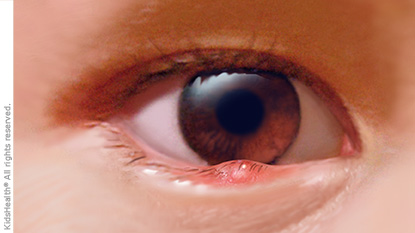Also called: Hordeolum
As health problems go, a stye is usually just a minor annoyance and rarely cause vision problems.
What's a Stye?
A stye is a red, painful bump on the eyelid, caused by a backed-up oil gland. It could appear on your upper or lower eyelids, or on the inside or the outside of the eyelids, near the edge of the eyelid where the eyelashes are. Styes are usually easy to get rid of.
Why Do Styes Happen?
Your eyelids have lots of oil glands that act like the water sprinklers on lawns. They make a special oil that mixes with tears to keep eyes lubricated.
Sometimes, these glands can get clogged up with old oil, dead skin cells, and old skin bacteria (our skin has bacteria on it all of the time — just not enough to cause infections). When this happens, the glands can't act like water sprinklers anymore. Instead, they're suddenly more like water balloons — big and full of liquid that can't get out.

The result? You look in the mirror and see a little bump on your upper or lower eyelid (it might look like a zit). A stye can become infected and get very red and swollen.
What Can I Do About a Stye?
The first thing you want to do is help the clogged-up oil get out of the stye. Applying warmth can make the oil become more liquid. The best way to get warmth to your oil glands is by using a washcloth that's been soaked in warm water. Make sure the water isn't so hot that the washcloth could burn you. Put the washcloth over your eye for a few minutes. You can repeat this several times a day.
You also can try cleaning your eyelid with special eye-scrub soap (available at drugstores) or watered-down baby shampoo (not with regular soap or shampoo), which is intended to not hurt eyes. Soak a cotton swab in the solution and use it to clean your eyelid.
If you wear contacts, switch to wearing glasses until the stye goes away. Clean your contacts really well before using them again to remove any germs.
If your eyeball hurts or you can't see properly, call your doctor. You'll also need to see a doctor if you have swelling and redness beyond your eyelid, like in your eye or other parts of your face.
What if a Stye Doesn't Get Better?
The stye should begin to improve over a few days with warm compresses and lid hygiene. If it's not getting better or symptoms get worse, call your doctor.
If you have a stye, the doctor may give you an antibiotic cream to use on your eyelid or prescribe antibiotic pills. In rare cases, a doctor may need to make a tiny cut in an eyelid to let out the clogged-up material. The doctor also will be able to tell if you have something other than a stye and treat that.
Some people are more likely to get styes than others. If you find you get a lot of styes, let your doctor know.
Can Styes Be Prevented?
Getting one stye makes a person more likely to get another. You can reduce your risk of getting styes in the future by doing a few simple things:
- Clean your eyelids every day or every couple of days with the diluted baby shampoo or special eye-scrub soap.
- Disinfect contact lenses according to the instructions.
- Remove all eye makeup completely before going to bed.
- Throw away mascara, liquid eyeliner, and eye shadow 3 months after you first use them.
- Don't share towels or washcloths with anyone who has a stye.
- Wash your hands, and do it often. Your eyes (and the rest of your body) will thank you!


